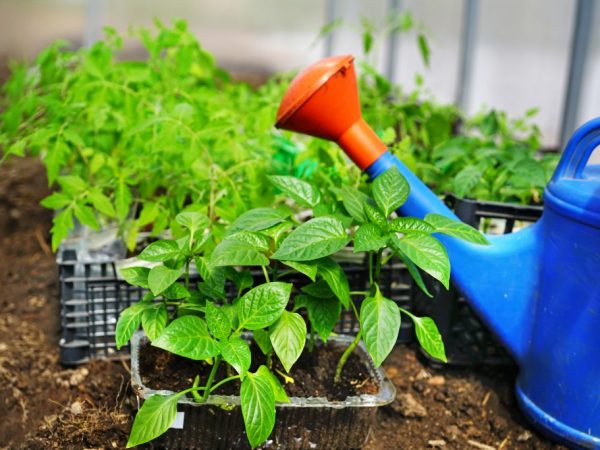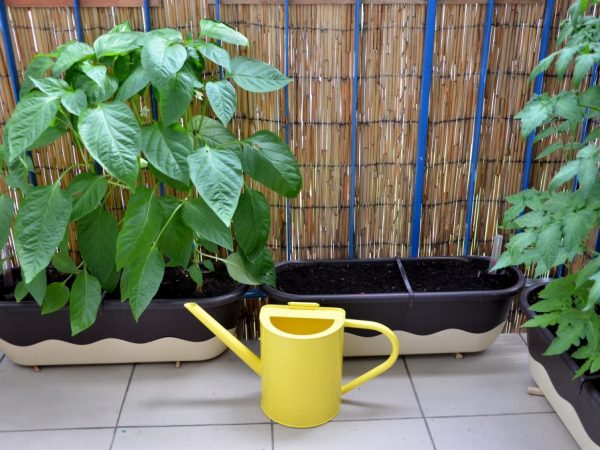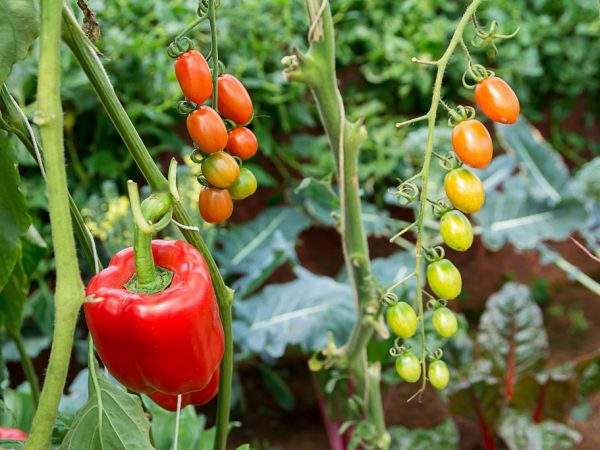Rules for planting peppers and tomatoes in the same greenhouse
It is not always possible to organize a separate greenhouse for each crop - for onions, eggplant, tomatoes, potatoes, and so on. What to do in the event that this cannot be done, because not all plants can grow nearby, some of them absolutely cannot be planted together. Is it possible to plant peppers and tomatoes in the same greenhouse, will such a neighborhood harm the crop? Today we will talk about whether such a neighborhood is allowed, what are the features of growing such crops in one greenhouse, and so on.

Rules for planting peppers and tomatoes in the same greenhouse
Growing features
As mentioned earlier, ideally, each crop should be grown in a separate greenhouse, but it is technically impossible to do this for many reasons. Today we will talk about the simultaneous cultivation of peppers with tomatoes.
It is worth mentioning right away that both plants belong to the same family - nightshade, which makes such a neighborhood possible in principle. If we were talking about the parallel cultivation of cucumbers and tomatoes or potatoes and onions, everything would be different here, since the plants belong to different families: the tomato, as already mentioned, belongs to the nightshade family, and cucumbers to the pumpkin family, about this indicates a large number of seeds inside the vegetable.
Despite the fact that peppers and tomatoes are representatives of the same family, each crop requires special growing conditions, so further we will talk about the differences in the agricultural technology of each vegetable.
Basic Rules
It is worth saying that belonging to the same family does not mean that it will be possible to grow them under the same conditions. Let us list what are the requirements for agricultural technology in peppers and tomatoes.
Tomatoes
- Growing tomato seedlings requires relatively low moisture indicators, it is desirable that the hygrometer does not rise above 60%, only in this way the seeds will successfully pass the germination stage after sowing or planting
- In no case should tomatoes be poured, it is strictly forbidden to irrigate in such a way that water falls on the tops
- As for airing, do not be afraid, drafts, on the contrary, there should be a maximum of airing
- The temperature in the greenhouse should be in the range from 22 to 24 degrees above zero, lowering the temperature is critical
Pepper
- Pepper seedlings simply adapt to a variety of moisture conditions, bear fruit, both at low rates and at significantly high
- When watering, frequent watering is allowed, the plant is not afraid of direct moisture on the leaves, which cannot be said about tomatoes
- The culture does not require frequent ventilation of the greenhouse, it can bear fruit even under the condition of stagnant air, it is better to avoid drafts
- The ideal temperature for growing a crop is about 27 degrees, the conditions remain the same for open field conditions
Conditions for landing
In order for the plants not to interfere with the growth and development of each other, it is worth approaching the preparatory stage as responsibly as possible, that is, choosing the right plant varieties, and also carefully studying the planting scheme for each of them, only after that plant the seedlings.
The first thing to take care of is to properly prepare the soil for seedlings, namely to fertilize it as much as possible with minerals and trace elements. In addition, do not forget that both pepper and tomato are among those crops that love warmth and light. For this reason, the soil should be generously flavored with peat, because this substance is able to retain heat for a long period. This is especially true if the planting was carried out in late winter - early spring, when the probability of frost is still real.

First of all, you need to select compatible varieties.
In addition, do not forget about the most important stages of growing pepper and tomato, namely, timely pinching, forming bushes, watering and fertilizing the plant, this will also determine the compatibility of crops.
Of course, all this applies to a greater extent to tomatoes, because the pepper does not require the obligatory formation of a bush, especially when it comes to tall bushes. For example, the Malyshok variety can be omitted. Here it will be enough to comply with the standard requirements for care, watering, groundbait. It is especially worth watching the state of the bush during flowering, it is highly likely that during the care procedure, you can accidentally shake off the pollen, which will call into question the ovary of the fruit.
Organization of landing
We received an answer to the question whether it is possible to grow peppers and tomatoes nearby. Now we will find out how to implement all those agrotechnical conditions that apply to one and the second vegetable. If you do not have the opportunity to allocate separate greenhouses for each of the vegetables, you should familiarize yourself with two options for solving the problem, which are most often used in practice.
Separating cultures with foil
The simplest and easiest to implement is to separate the growth of two vegetables using the simplest film. When pulling it, it is important to take into account the fact that it is pulled from ground level to the very roof. Thus, you will be able to create the same microclimate that was written about earlier in order to maximize the chances of harvesting a rich harvest.
However, it should be said that the film creates a barrier to air penetration, so you need to make sure that a constant flow of air is provided to the tomatoes. Also, one of the requirements is the organization of separate entrances, usually they are equipped at the ends. An important condition is the fencing not only of the airspace, but also of the soil. As for the location of the beds, they should be placed in such a way that they are located on different sides, separated by a passage in the middle. If it is problematic to make such a passage, then you can divide the growth of crops using a sheet of slate or metal.
Landing without separation
You can place peppers and tomatoes in the same greenhouse without stretching the film. To bring this option to life, you need to learn how to properly use the greenhouse area. As for the pepper, it is better to plant it in the southern part of the greenhouse, since it is considered more thermophilic. It is recommended to plant tomatoes in the center and on the north side. Moreover, you should not give up space near doors or windows, since the culture is absolutely not afraid of drafts.
In this version, it is allowed to plant not only peppers and tomatoes in a greenhouse. You can also add radishes and beans to such a greenhouse, as well as garlic, celery and parsley. The exceptions are peas, eggplant, onions and dill, which negatively affect the growth of tomatoes. It is worth saying that eggplant is one of the most capricious vegetables to grow.

It is important to place the plants correctly in the greenhouse.
When using the greenhouse in this way, the main rule should be taken into account: in no case do not plant hot peppers next to a sweet variety, for example, Bulgarian, just like cucumbers cannot be planted with onions with eggplants, their compatibility is close to zero.
Recommendations
In order for the plants to adapt as best as possible to such a neighborhood, it is worth following a number of rules:
- The greenhouse itself should be in the south
- It is recommended to place the beds in the direction from north to south
- The height of the beds should be at least 20 cm, while the top layer of soil must be discarded, just like for open ground
- In order to keep warm in the soil, you need to fertilize the ground with manure, for the same purpose it is recommended to equip the greenhouse with the simplest heating system, even in May there may be frosts
- In order for the air to penetrate into the soil better, it is recommended to sow green manures into the ground immediately after harvesting, this will have a positive effect on the structure of the soil
Diseases and pests
It is worth saying that with the simultaneous placement of peppers and tomatoes in the same greenhouse, there is a possibility that the plant will be infested with parasites, for example, aphids or slugs. We will learn how to deal with this problem and how it can be prevented.
Aphid
As mentioned earlier, with the simultaneous placement of peppers and tomatoes, problems can arise, first, consider the defeat of aphids. This problem most often occurs during the summer period, namely, in its last month. If this problem occurs, it is worth choosing an effective remedy that will once and for all save you from the invasion of a flying insect.
Healthy garden preparation
Currently, the best solution to combat this problem is the "Healthy Garden" drug. In order to destroy aphids, it is necessary to dissolve the "Healthy Garden" powder with water strictly in accordance with the instructions, and then thoroughly spray the tomato bushes with peppers.
Spraying is best done in the evening, as aphids are most active. If the procedure was carried out correctly in accordance with the instructions and according to the calendar, then the pest will disappear already on the second day.
Fitoverm (or Iskra Bio)
This is also a drug with good reviews, it will help get rid of aphids in the shortest possible time, provided that peppers and tomatoes are planted in the same greenhouse. After spraying with Fitoverm, drops of the drug are absorbed by the leaves, accumulating it in the cell sap. Its advantage is that in addition to the actual fight, it has a protective function, that is, it protects the plant for another three weeks.
Moreover, the action of Fitoverm extends not only to aphids, but also to other pests, both flying and not. Do not be afraid that after spraying the vegetables will become unsuitable for consumption, this is not the case. Already on the third day after spraying, both pepper and tomato can be eaten.
Slugs
When planting peppers and tomatoes at the same time, slugs and snails can be a common problem in the beds. They rarely eat tomatoes, but sweet and bitter peppers are a favorite treat. If you find holes and tunnels on vegetables, know that these are slugs.
The problem can be solved with the help of slate, which is used to lay out tunnels between the beds. Toward evening, the very same pests will gather on such an obstacle, you just have to turn over the fence and crush the slugs. It is recommended not to remove the killed parasites, since the next day their relatives will come to eat the remains without reaching the green leaves. So in a few days you can get rid of all the parasites.
As a conclusion, it must be said that peppers and tomatoes in the same greenhouse can get along, their compatibility is high, since they belong to the same family and require similar conditions of detention, which cannot be said about the neighborhood with cucumbers. You are required to follow the recommendations described above, then you can harvest vegetables without damage and loss.


